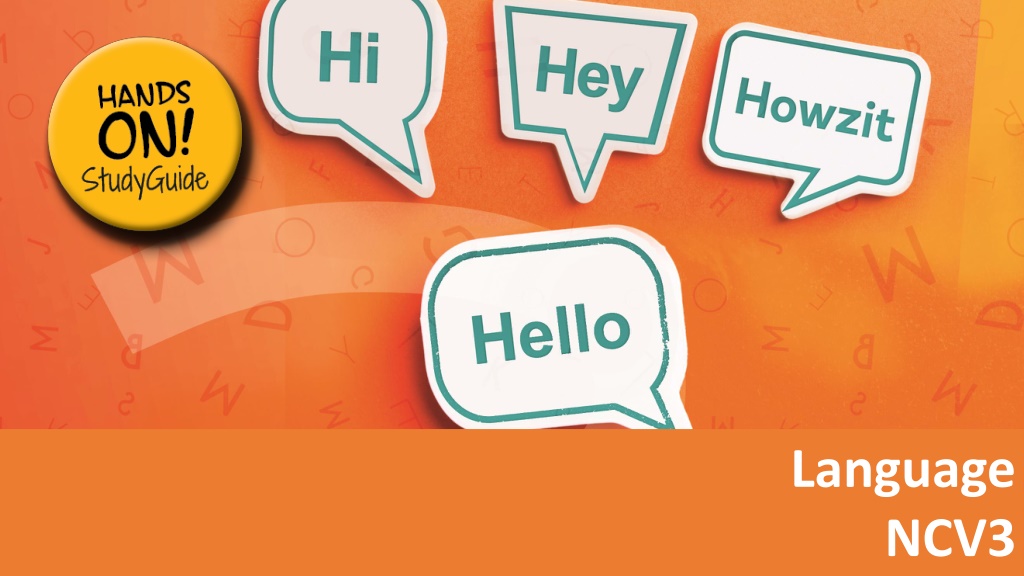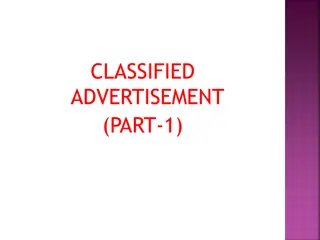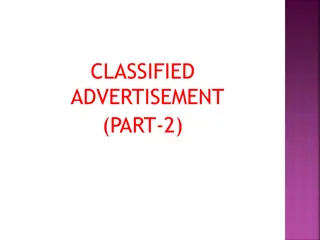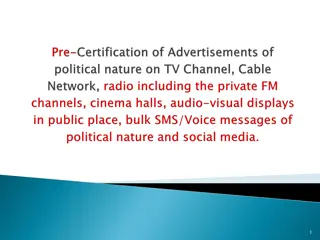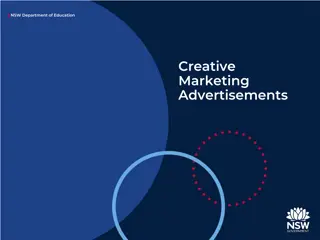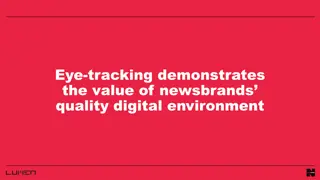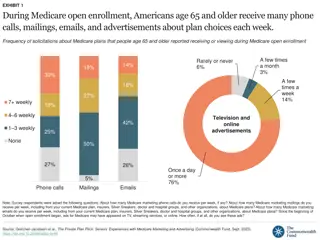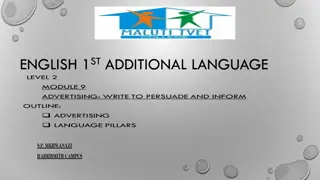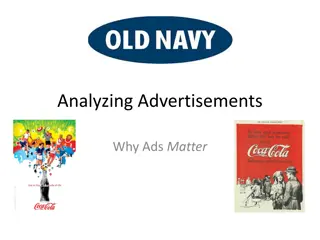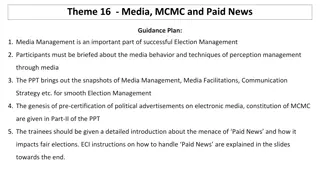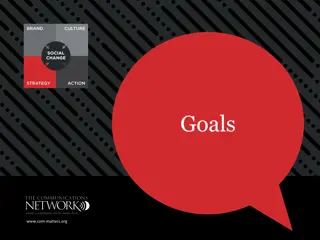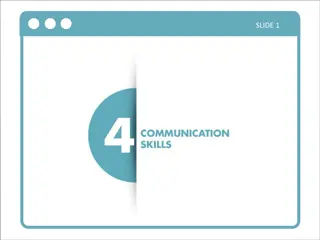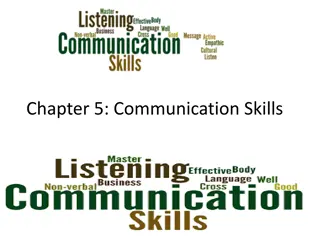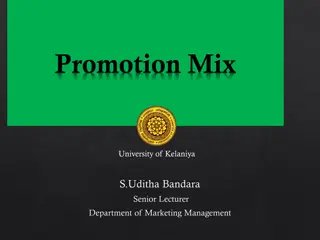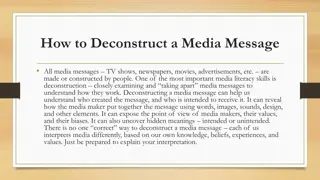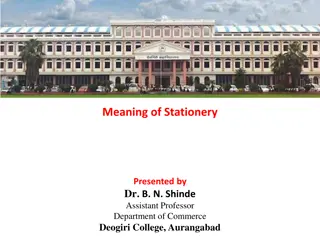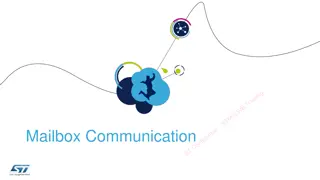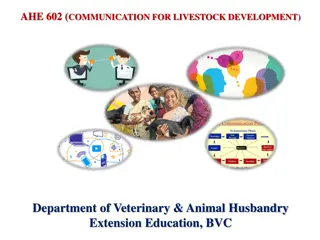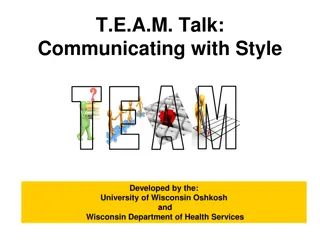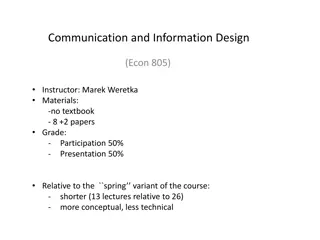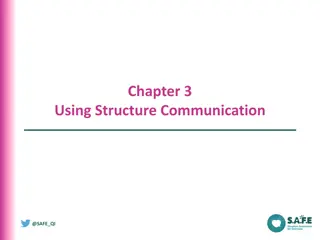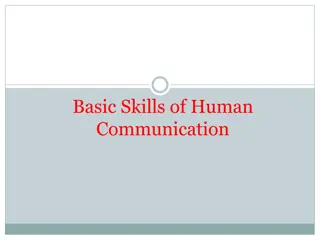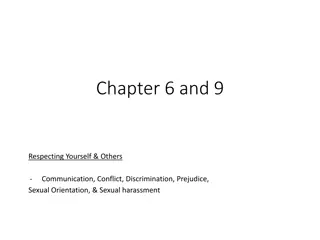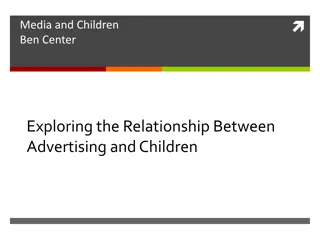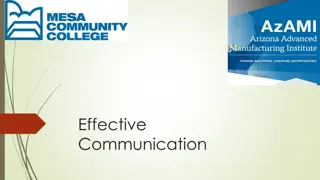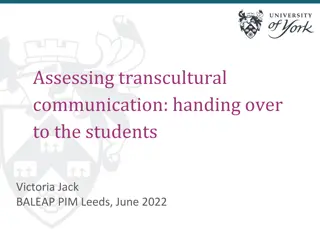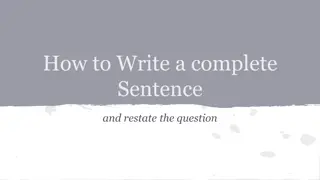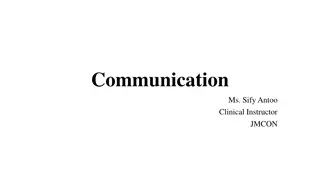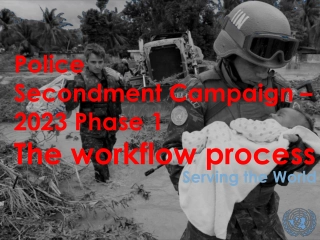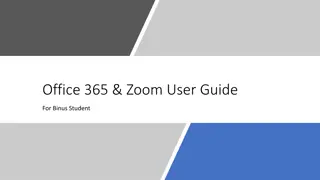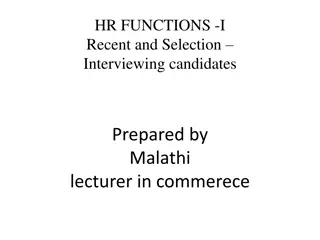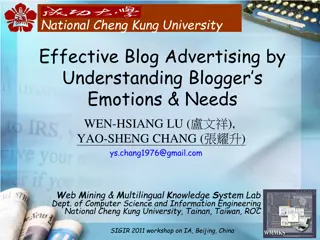Effective Techniques for Office Advertisements and Communication
Learn about different types of advertisements such as classified, display, and magazine ads along with the importance of slogans and logos. Discover the benefits of telephone conversations and how to have successful dialogues and discussions in the workplace. Improve your communication skills for better business outcomes.
Download Presentation

Please find below an Image/Link to download the presentation.
The content on the website is provided AS IS for your information and personal use only. It may not be sold, licensed, or shared on other websites without obtaining consent from the author. Download presentation by click this link. If you encounter any issues during the download, it is possible that the publisher has removed the file from their server.
E N D
Presentation Transcript
Language NCV3
Module 1 Advertisements and office correspondence CLASSIFIED ADVERTISEMENT (REVISION) Classified advertisements appear in newspapers and certain magazines. They are found in columns under a suitable heading. Classified advertisements are very popular because they are cheap, and newspapers often have promotions where, e.g. they will advertise your products/services for free for a few days. Or they will place your advertisement for six days but you only pay for five days. www.futuremanagers.com
Module 1 Advertisements and office correspondence (continued) DISPLAY ADVERTISEMENT (REVISION) Display advertisements are bigger than classified advertisements. They are very expensive and usually take up two or more columns. They are often blocked, with a colourful design, slogan and/or logo. www.futuremanagers.com
Module 1 Advertisements and office correspondence (continued) SLOGAN AND LOGOS (REVISION) A slogan is a short, catchy, memorable phrase (something that we remember) that is used to promote a product or service. www.futuremanagers.com
Module 1 Advertisements and office correspondence (continued) MAGAZINE ADVERTISEMENT Magazines are more expensive than newspapers because they are printed on better quality paper. Magazine advertisements, therefore, have a much longer shelf life. Also, readers of magazines are very loyal to their favourite publication and advertisers benefit from this loyalty. Most readers enjoy a well presented, out-the-box advertisement. www.futuremanagers.com
Module 1 Advertisements and office correspondence (continued) TELEPHONE CONVERSATION To have a direct telephone conversation with the right person has many advantages. Some of the advantages are that it can solve problems, clear uncertainty instantly and save time. A telephone conversation relies on voice only. How we speak is a reflection of ourselves as well as our workplace. We can hear a friendly, unfriendly, helpful, rude, effective or ineffective tone. www.futuremanagers.com
Module 1 Advertisements and office correspondence (continued) DIALOGUE AND DISCUSSION How to have successful dialogue and discussion: 1. Show interest and listen to others. 2. Share ideas and experiences. 3. Take turns asking and answering questions. 4. Be tactful and sincere and don t be argumentative or self-centred. 5. Clarify meaning where necessary. 6. Use appropriate body language and make eye contact. www.futuremanagers.com
Module 1 Advertisements and office correspondence (continued) TELEPHONE MESSAGE How to take down a telephone message: 1. Give the name of the person for whom the message is. 2. Give the name of the person from whom the message is (the caller). 3. Give the caller s contact number/s. 4. Give the caller s job title and name of company or department. 5. Give the date and time of the call. 6. Give the message and the action required, e.g. to phone back. www.futuremanagers.com
Module 1 Advertisements and office correspondence (continued) FAX Fax is the shortened word for facsimile. It is a document that is transmitted by one fax machine to another fax machine via telephone lines. Advantages of faxing are that one can send larger documents and a signed signature on a fax makes it legal. www.futuremanagers.com
Module 1 Advertisements and office correspondence (continued) INTERNAL MEMORANDUM The internal memorandum (also called a memo), is used within a company. It is used to circulate information among colleagues or employees in a firm. A memo can be sent from one branch to another, from one department to another or from one office to another as long as it is not sent out of the organisation. www.futuremanagers.com
Module 1 Advertisements and office correspondence (continued) E-MAIL (REVISION) Electronic mail, known as e-mail or email, is a method of exchanging digital messages from a sender to one or more recipients. Communicating via e- mail has become very popular. It is quick, effective and inexpensive. Many businesses rely on e-mailing for most of their business correspondence. www.futuremanagers.com
Module 2 Forms, accident reports and eyewitness reports PURPOSE OF A TEXT To inform; To educate; To entertain; To advertise; To warn; To persuade; and To manipulate; To describe. www.futuremanagers.com
Module 2 Forms, accident reports and eyewitness reports (continued) FORMS A form is a printed or written document with blank spaces in which to fill in factual information like surname, name, contact numbers, dates, etc. The filling in of forms is part of daily business routine, e.g. for credit information, job applications and leave application forms. It is very important that forms are filled in correctly. www.futuremanagers.com
Module 2 Forms, accident reports and eyewitness reports (continued) ACCIDENT REPORT An accident report is a descriptive report. It means that the facts are described in detail. Examples of descriptive reports are: Accidents at work during working hours Witness or eyewitness reports Police reports on accidents, criminal offences, burglaries, etc. www.futuremanagers.com
Module 2 Forms, accident reports and eyewitness reports (continued) EYEWITNESS REPORT it is very important to give all the necessary facts when you write an eyewitness report. When writing a report, stick to facts and answer the Wh- and H-questions: Who? What? Where? When? Why? How? www.futuremanagers.com
Module 2 Forms, accident reports and eyewitness reports (continued) INTRODUCING A GUEST SPEAKER There are many personal, academic and professional functions that need a guest speaker, To make it easier for yourself, do the following before you introduce a guest speaker: Find out as much about the speaker as you can. Find out why this particular speaker was invited. Interview the speaker, if possible. Ask for a short biography. www.futuremanagers.com
Module 2 Forms, accident reports and eyewitness reports (continued) VOTE OF THANKS We deliver a vote of thanks at the end of a function to say thank you to everybody who was involved in the organising of the event. The people to thank could include the following: the main organiser, catering staff, sound technicians, admin staff, sponsors, etc. www.futuremanagers.com
Module 3 Interviews and reports INTERVIEWS An interview is a pre-planned formal meeting where a person (the interviewer) questions, consults or evaluates another person (the interviewee). The purpose is to exchange information, feelings and knowledge. Sometimes more than one interviewer - a panel - conducts an interview. www.futuremanagers.com
Module 3 Interviews and reports (continued) REPORTS Routine reports form part of workplace routine. A descriptive report describes a situation in detail, e.g. an accident report and an eyewitness report. A narrative report tells a story . Narrative writing is well suited to reports that relate events in chronological order - in other words, events that have a beginning, middle and end, e.g. a feedback report and a progress report. Investigative reports are expository reports written to expose or explain a specific situation. www.futuremanagers.com
Module 4 Visual texts and summaries PAMPHLET (REVISION) We usually find some of the following features on a pamphlet: A title which explains the subject of the pamphlet. Headings and sub-headings sometimes presented as questions. Different text features. A concise description of the product or service. Enough white space. Contact details like address, telephone number and website. www.futuremanagers.com
Module 4 Visual texts and summaries (continued) BROCHURE A brochure is an advertising leaflet - written to sell a product or a service. Brochures are usually distributed by mail (placed in private post boxes); handed out (often at traffic lights); displayed in brochure racks near tourist attractions; and placed in hotels. www.futuremanagers.com
Module 4 Visual texts and summaries (continued) FLYER Flyers are widely distributed amongst members of the public. The purpose of a flyer is to persuade someone to buy a product or use a service. Like pamphlets, flyers are a low-cost form of mass marketing as they are inexpensive to produce. www.futuremanagers.com
Module 4 Visual texts and summaries (continued) CARTOONS AND COMIC STRIPS Cartoons and comic strips are humorous/amusing drawings in newspapers and magazines. Although they are intended to be humorous, some are more serious. The cartoonist can use dialogue and drawings (art work) to comment on current and political topics. Cartoons are popular all over the world as everyone enjoys viewing or reading a humorous illustration of something or someone newsworthy. www.futuremanagers.com
Module 4 Visual texts and summaries (continued) MAIN AND SUPPORTING IDEAS When we read a text that s easy to understand, we have no trouble sifting the main (key) ideas from the less important ideas. There are times, though, when we have to read and reread a difficult text in order to understand it; especially if we have to summarise it. The first step when summarising any text, is to find the topic, main idea and supporting ideas. www.futuremanagers.com
Module 4 Visual texts and summaries (continued) POINT FORM SUMMARIES How to make a point form summary: 1. Underline the topic sentence. 2. Underline the main ideas. 3. Underline the supporting ideas. 5. Rewrite the main ideas in your own words. 6. Shorten the text. www.futuremanagers.com
Module 5 Meeting documentation in the workplace BACKGROUND TO MEETING PROCEDURE It is important to know the background to meeting procedure before meeting documentation can be explained. A club or society consists of members. Some of these members are elected to serve on the committee. www.futuremanagers.com
Module 5 Meeting documentation in the workplace (continued) TYPES OF MEETINGS We distinguish between two types of meetings Public meetings may be attended by any member of the public. Examples are political rallies and public marches. Notice of these meetings usually appears in newspapers, pamphlets and on posters. Private meetings are attended by members only, e.g. a sports club or a cultural society. Although non-members are allowed to attend, they may not vote. www.futuremanagers.com
Module 5 Meeting documentation in the workplace (continued) DUTIES AND POWERS OF A CHAIRPERSON Prepare the agenda for the meeting with the secretary. Ensure that the members have been notified of the meeting. Open the meeting. Check for a quorum. Follow the order of items on the agenda. Ask the secretary to read the minutes of the previous meeting. Keep control of the discussions and bring the meeting to order. www.futuremanagers.com
Module 5 Meeting documentation in the workplace (continued) DUTIES AND POWERS OF A CHAIRPERSON (CONT) Announce the result after a vote and exercise a casting vote if there is a deadlock. Close the meeting at the proper time. If all matters have not been concluded then the meeting is adjourned until a later date. Make sure that the meeting has been correctly minuted. Follow up all decisions taken and ensure that they are carried out. www.futuremanagers.com
Module 5 Meeting documentation in the workplace (continued) DUTIES AND POWERS OF A SECRETARY Draft the notice and agenda of the meeting after discussion with the chairman. Ensure that the minutes of the previous meeting are written up and a copy is sent out with the notice and agenda for the meeting. Prepare the venue. This includes the layout of the room, visual aids, ventilation (heating or cooling), refreshments and leaving the venue clean and tidy after the meeting. www.futuremanagers.com
Module 5 Meeting documentation in the workplace (continued) DUTIES AND POWERS OF A SECRETARY (CONT) Have any reports or information ready which may have been asked for at the previous meeting. Arrive at the meeting ahead of time with the membership list and minute book. Circulate the attendance register and make a note of all apologies. Make a note of the starting and closing time of the meeting. Take accurate minutes by noting all the important points. www.futuremanagers.com
Module 5 Meeting documentation in the workplace (continued) NOTICE OF A MEETING The notice of a meeting is sent out by the secretary to all members to inform them about the next meeting. The following information must appear: Type of meeting, e.g. monthly, quarterly, special meeting; Venue; Day; Date; and Time. www.futuremanagers.com
Module 5 Meeting documentation in the workplace (continued) AGENDA OF A MEETING The agenda is a numbered list of business matters that will be discussed during a meeting. Basically this list always looks the same, with Attendance register, Apologies, Opening and welcome, etc. However, every meeting also has its own, unique matters that have to be discussed which appear on the agenda under New business. www.futuremanagers.com
Module 5 Meeting documentation in the workplace (continued) MINUTES OF A MEETING Minutes are an accurate, official report of the activities and decisions taken during a meeting. In other words, it is a report of what happened at a meeting. The secretary usually writes the minutes soon after the meeting and records them in a minute book. The secretary should ensure that all the members receive a copy of the minutes - whether or not they were present at the meeting. www.futuremanagers.com
Module 5 Meeting documentation in the workplace (continued) CORE NOTES AND EXPANSION OF CORE NOTES Core notes refer to only the most important keywords/ phrases used to sum up the essence of a situation. When we write in core notes, we use a form of telegram style. We do not use adjectives and adverbs and also leave out personal pronouns and articles. When we expand core notes, we add in descriptive words (such as adjectives and adverbs), as well as pronouns and articles. www.futuremanagers.com
Module 6 Speeches and presentations NON-VERBAL COMMUNICATION Non-verbal communication includes facial expression, gestures and signs, tone, volume, stress, tempo, pauses, and projection. www.futuremanagers.com
Module 6 Speeches and presentations (continued) VISUAL AIDS If you select a visual, audio or audio- visual aid carefully and use it correctly, it can contribute hugely to making your speech successful. Aids can be: Cartoons; Transparencies; Diagrams; Slides; Graphs; Posters; Maps; Photographs; and Music; PowerPoint. www.futuremanagers.com
Module 6 Speeches and presentations (continued) ACTING AS PROGRAMME COORDINATOR AND DIRECTOR 1. Find out beforehand what the function is about. 2. Find out exactly what you are expected to do. 3. Find out about the audience, e.g. size, age, gender and interest. 4. Know the order of the programme. 5. Introduce yourself. www.futuremanagers.com
Module 6 Speeches and presentations (continued) ACTING AS PROGRAMME COORDINATOR AND DIRECTOR (CONT) 5. Welcome the guests and tell them about the procedure. 6. Introduce the speakers or participants. 7. Follow the programme and stick to the time limit. 8. Keep the guests informed and prevent boredom. 9. Ensure that the event runs smoothly. www.futuremanagers.com
Module 6 Speeches and presentations (continued) PRESENTING AN AWARD Suggestions on how to present an award: 1. Say how glad you are to be there, e.g. It is a great privilege to be here.... 2. Say that the nominees displayed exceptional talent. 3. Provide some background information about the award winner. 4. Shake the person s hand and look him/her in the eyes when you hand over the award. 5. Sometimes you can ask the winner to say a few words. www.futuremanagers.com
Module 6 Speeches and presentations (continued) ACCEPTING AN AWARD Suggestions on how to accept an award: 1. Say how glad you are to be there. 2. Express how grateful you are to everyone who helped you. 3. Say how pleased you are for the recognition of your hard work and achievements. 4. Explain what the award means to you. 5. Thank your employer/mentor/colleagues/family for their loyal support. www.futuremanagers.com
Module 6 Speeches and presentations (continued) MAKING A SPEECH AS AN INVITED GUEST SPEAKER A guest speaker is usually given the topic of the speech s/he must deliver. A successful speech always has an introduction, body and conclusion. www.futuremanagers.com
Module 6 Speeches and presentations (continued) PANEL DISCUSSION A panel discussion is when a group of people, usually not more than eight, are gathered together to discuss an announced topic before an audience. The purpose of panel discussions is to share different information from different sources. The panel members are chosen because they are experts in the topic being discussed. They each have a turn to talk about a particular aspect of the topic. www.futuremanagers.com
Module 6 Speeches and presentations (continued) UNPREPARED READING ALOUD How to read an unprepared text aloud: Stand up straight, look comfortable and make eye contact with the audience. Read fluently by letting your eyes move ahead of your voice. Project your voice by looking up when you read. Pronounce words clearly and correctly. www.futuremanagers.com
Module 6 Speeches and presentations (continued) UNPREPARED READING ALOUD (CONT) How to read an unprepared text aloud: Don t read too fast or too slowly. Put expression in your voice. Use gestures where you can. Match your facial expression to what you are reading. www.futuremanagers.com
Module 6 Speeches and presentations (continued) LISTENING How to be a good listener: Keep an open mind and be willing to listen. Make and keep eye contact naturally. Pay attention and concentrate on the speaker s voice and words. Recognise the speaker s non-verbal signs. Listen for verbal clues to the main points. Respond non-verbally to show you are listening. www.futuremanagers.com
Module 6 Speeches and presentations (continued) NOTE-TAKING How to take notes: Listen for clues to main ideas. Watch for clues to main ideas and facts. Listen for supporting ideas. Listen for clue connectors. Use abbreviations to save time. Draw mini diagrams/mind-maps. www.futuremanagers.com
Module 7 Creative texts FACT AND OPINION Facts are based on the truth and can be proven. Opinions are what we believe or think about something - our point of view or the way we experience something. They involve our emotions (feelings) about someone or something. www.futuremanagers.com
Module 7 Creative texts (continued) OBJECTIVE AND SUBJECTIVE LANGUAGE Objective language gives only facts. The writer tells what happens without giving an opinion. Subjective language describes our opinions, feelings and emotions. www.futuremanagers.com
Module 7 Creative texts (continued) LITERAL AND FIGURATIVE LANGUAGE Literal means adhering (sticking) to the basic facts, or to the standard meanings of words. When we use language literally, we say something exactly as it is. Figurative writing is more expressive and emotional. Descriptive language used in an original, interesting way creates a special effect. Figures of speech and idiomatic expressions are often used to achieve the desired effect. www.futuremanagers.com
